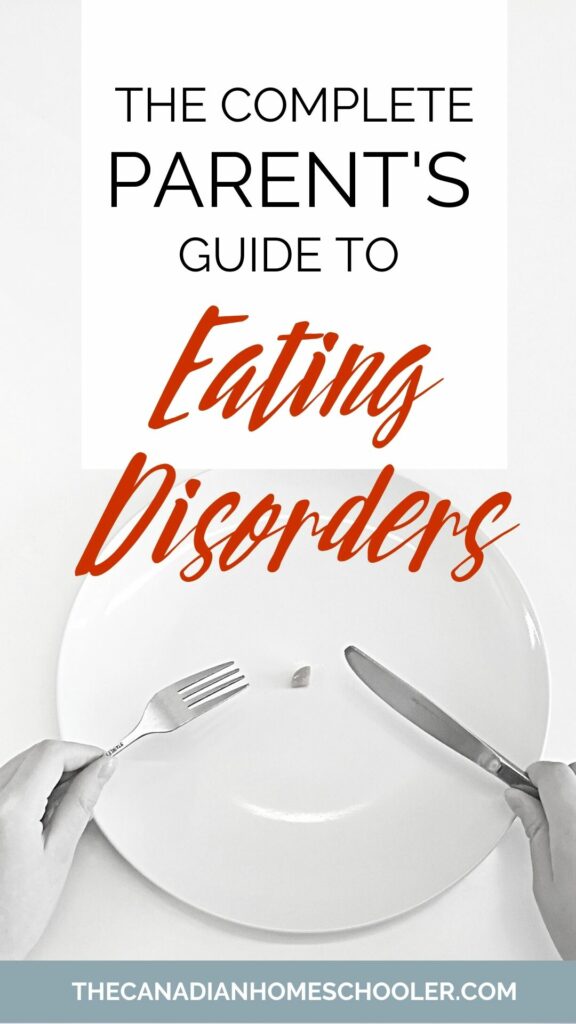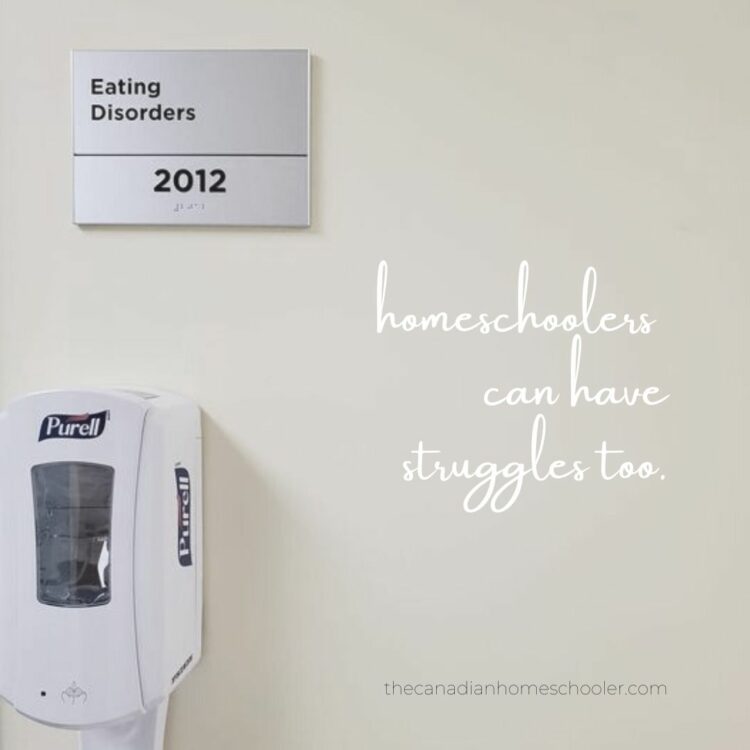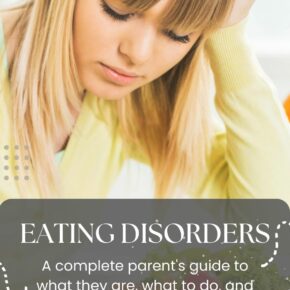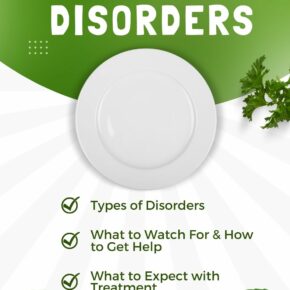Eating Disorders. Medically unstable. Hospitalization. All these are words that no parent expects or wants to hear. But it happened to us, and although I’m not an expert – I do want to help any other parent who is dealing with a similar struggle and doesn’t know what to do. In this blog post, we are going to talk about everything food disorder related – from definitions and myths, to signs to watch for, to understanding what is going on with your child and how to handle the long-term treatment. Also, I’m going to share with you resources who ARE experts, so if you have more questions or need help – you know where to turn.

What is an Eating Disorder?
The dictionary describes eating disorders as “any of a range of mental conditions in which there is a persistent disturbance of eating behaviour and impairment of physical or mental health.” But what does that mean?
First of all, it’s important to understand that eating disorders are actually mental health struggles that impact a person’s eating. These struggles can seriously affect their physical health as well as their mental health. How exactly they are affected is dependent on what kind of eating disorder they have, their personal bodies and the foods they are willing to intake, how early in the struggle the problem is discovered, and a plethora of other parameters.
Basically, an eating disorder is when someone has a negative relationship with food for whatever reason and that causes medical issues of some kind.
Types of Eating Disorders
Although most of the media attention and awareness in the public revolves around two types of eating disorders (anorexia and bulimia), there are actually several different types and classifications of eating disorders. Here are some of the most common.
Anorexia Nervosa
The most deadly of all eating disorders, people who struggle with this type of disorder tend to be obsessive about their weight and restrict their caloric intake (or counter their intake by throwing up or over-exercising.) They are severely underweight and are unable to gain or maintain a healthy weight – often out of fear of “being fat” and believing they are overweight when the opposite is the truth. Often, they don’t see anything wrong with their behaviour. Although it can seem like dieting, it’s more controlling and desperate – excessive and obsessive. Unfortunately, this type of eating disorder is also the most fatal. It’s often deeply entangled with mental health struggles with depression and suicide.
Signs & Symptoms
- obsessive thoughts about food, calories, weight, body image, etc
- constantly checking calories on packaging
- weight loss
- stomach pain and digestive issues
- loss of menstrual cycle OR delay in menstrual cycle beginning if the child hasn’t started cycles yet
- lethargy and low energy
- headaches
- always cold / purple feet (lack of proper circulation)
- dizziness / fainting
- irritability and irrationality, difficulty controlling emotions
- wearing many layers of clothing
- avoiding meals or eating with others
- excessive exercising
- difficulty thinking and processing thoughts
Bulimia
This eating disorder involves uncontrollably eating excessive amounts of food in a short period of time, then counteractively reacting by making themselves throw up or other methods of compensation in order not to gain weight. It can sometimes be referred to as a binge/purge cycle, although there are variations that don’t involve purging. Instead they might take part in prolonged fasting or over-exercising. A person struggling with bulimia can be of any weight and size.
Signs & Symptoms
- weight fluctuations
- swollen and/or sore throat
- tooth yellowing and decay
- excessive time in the washroom after eating
- smells of vomit
- drinking lots of water
- bloating
- anxiety about food
- avoids eating with others
Binge Eating
Similar to bulimia, binge eaters eat an excessive amount of food in a short period of time, usually feeling out of control. However, they don’t respond in any way to counteract their overeating behaviours. Binge eating typically leads to weight gain. A high number of people with this disorder also struggle with mental health challenges such as mood and anxiety disorders. Although many people have periods of time where they overeat, binge eating happens on a regular basis and is typically accompanied by shame and guilt over their behaviour.
Signs & Symptoms
- weight gain
- sneaking and hiding food
- wearing clothes to hide their body
- anxiety and guilt around food
- eats quickly
ARFID (Avoidant – Restrictive Food Intake Disorder)
Also known as Selective Eating Disorder, this particular disorder isn’t based around body image or weight, but instead is more refusing to eat due to fear or sensory issues. While most eating disorders begin in the teen and young adult range, ARFID has been known to be diagnosed much earlier in childhood. It can be caused by traumatic experiences such as vomiting or choking, which leads to a fear of reoccurance. Or, it can be a refusal to eat specific foods deemed “unsafe” due to unpredicatable flavours, textures, smells, or other criteria. Some people equate ARFID with “extreme picky eating” but it tends to be more rooted in a mental block around fear than a general disapproval of food. Limiting food to the point of too low caloric intake means a lack of growth and development in children and maintaining body functions in teens and adults, leading to physical health complications. People with ARFID can range from severely underweight to extreme obesity – depending on their safe foods and amount they are willing to eat.
Signs & Symptoms
- “picky eating” beyond childhood – only willing to eat a very specific set of foods they deem “safe” (although this list can change with time)
- little to no appetite
- weight loss
- lethargy and low energy
- difficulty thinking and processing thoughts
- irritability and irrationality, difficulty controlling emotions
- abdominal pain
- dizziness / fainting
- headaches
- always cold / purple feet (lack of circulation)
- fear of eating
- refusing to eat with others
There are several others as well. If the one you are wondering about isn’t on this list, please visit NEDIC for a more complete list.
Warning Signs of Eating Disorders to Watch For
Watch for the signs and symptoms listed above in the different types of eating disorders first, but there are some other things to watch for as well.
- Changes in attitude – Those who struggle with an eating disorder may become more withdrawn and self-isolate. Outgoing people may start to stay home and hide. Teens may be more sullen and rarely smile, or snapping with anger over something seemingly insignficant.
- Changes in behaviour – Favourite foods may no longer get eaten. They may get busy at meal times or skip meals for a variety of reasons. They may spend more time in the bathroom or act sluggish and slow. They might seem sneaky or dishonest. Or they may suddenly show an interest in exercise and participate in activities more than ever before. There might even be more concerning behaviours like self-harm.
- Changes in thinking – Once studious children may become frustrated by their schoolwork, feel unable to handle subjects that never caused them trouble before, can’t seem to remember information they are learning (short term memory loss), find it hard to think of words or follow conversations.
- Body changes – sudden weight loss, hiding their body in oversized clothes, looking like a “skeleton” with skin.
- Changes in language – You might start hearing things about calories, “good/bad” foods, different diets, negative self-talk, a generally negative perspective, comments like “I’m not hungry” or “I’m full.”

In our experience, it took retrospect to connect the dots in the signs and symptoms. Collapsing in the bathroom after getting out of bed too quickly. Purple feet. Struggling with schoolwork. Hiding when it was meal time and refusing to eat much. Food sneakily dumped in the garbage. Grabbing snacks like granola bars throughout the day and drinking lots of water. An extreme growth spurt without a matching weight increase. Gaunt hands and cheeks. Sleeping a lot and angry outbursts. Headaches. In truth, before hospitalization – almost everything that was going on was able to reasoned away to other things – especially under the label of “teenager.”
Common Myths About Eating Disorders
Only girls have eating disorders.
In truth, eating disorders can affect anyone – no matter what race, age, or gender. Admittedly, disorders that focus on weight and body image are more common in girls, while struggles such as muscle dysmorphia (ie wanting to have bigger body with defined muscles) are almost exclusive to males, but guys can struggle with any type of disordered eating, too. If you are concerned about your child, no matter which gender they are, don’t rule it out because it’s a “girl problem.”
Good parenting can prevent eating disorders.
It doesn’t really matter if you are a “good” family or if you are a homeschool family or if you have exposed your child to all kinds of foods or limited media for your kids. Eating disorders can still happen. Mental health messes with anyone. Clinics are full of people from all walks of life, different backgrounds and experiences – all struggling with food challenges. What CAN help is how you handle the illness and being an involved, proactive, and compassionate parent can help your child make progress with their recovery.
Eating disorders are caused by media, social media, parenting, and peers.
It is so much more complicated than these things. It’s not because you didn’t force your child to finish their broccoli when they were 5 or because you let them have an Instagram account that they are dealing with this disorder now. Researchers believe that it’s a combination of things like genetics, biological, social, behavioural, and psychological factors that are at play with the development of an eating disorder.
“Just eat a hamburger.”
So many people associate eating disorders with being underweight. And yes, it can be. However, some types lead to obesity. In some people, they look healthy and can maintain a standard body weight while struggling with disordered eating under the surface. As for the “just eat a hamburger” comments for someone who IS underweight- the truth is that someone who hasn’t eaten properly in a long time can run a risk of refeeding syndrome when they start to eat again. They can’t just eat something big and calorie-filled and magically recover. It’s a slow, careful process that requires medical supervision or they can die. This comment is body shaming and should be avoided.
What Should You Do If You Think Your Child Has An Eating Disorder?
Listen to me: THIS IS NOT YOUR FAULT. It’s going to feel like your fault. You are going to question every decision you’ve ever made for your child, especially around food. You are going to feel like a failure. Like you are a terrible parent. Like you didn’t see it and you should have. You are going to run through every experience you’ve had in the last year and wonder if you could have done something differently. But THIS IS NOT YOUR FAULT.
The most important thing to do right now is to get past any feelings of guilt, self-anger, shame, or disapproval that you might be feeling. They aren’t going to help you at this point. Shove them off to the side to deal with later if you need to. It’s important to focus on your child’s needs first.
If you have even an inkling of concern for your child in regards to an eating disorder of any type, take action immediately.
Getting help early is vital.
In the situation of extreme malnourishment, your child can die. Get them to your doctor or to the emergency department asap. Ask for help.
Do some research into these different types of eating disorders and the signs / symptoms they have. List all the little things that may not even be connected but *could* be. It might surprise you when you look back later. Bring it with you to the doctor appointment.
Open a conversation with your child, even if they aren’t willing to listen or participate. Be prepared for anger and denial. They might not want help, but you have to make that decision for them. Validate their feelings and struggles. Don’t cast blame or tell them they are bad – they already are struggling with negativity. They need you to come alongside as a support. Maybe even a support they don’t know they need. But don’t take no as an answer.
We were oblivious to the seriousness of the situation with my son’s health and, if it wasn’t for the extreme proactiveness of our family doctor insisting that we take action immediately – I don’t know if my son would be alive now. His heart was failing. At 15. And I had no idea.
Be prepared to advocate for your child along the way. Ask the questions you need to ask – even if they seem stupid or pointless. Question decisions and stand up for things you are concerned about. Don’t be afraid to be your child’s voice in this difficult situation.
Once you know what you are dealing with, you can move forward with intentional action steps. But the first step is getting help.
What to Expect If Your Child is Hospitalized
Our care team told me that the length of stay children and teens with eating disorders have is only seconded by cancer patients. Recovery from malnourishment is slow and challenging. They also tend to return for multiple stays. In the experience we had, the hospitalizations were fast – like unexpectedly the same day as our check up with a clinic. And they lasted a long time. Once was 6 weeks. Another for 3 weeks. Hopefully we won’t need to go back.
It will depend on the hospital where your child is admitted, but here are some things to know ahead of time.
- Some hospitals have designated eating disorder care rooms which have locked bathrooms and/or cameras to prevent and supervise dangerous behaviours such as purging.
- Blood work and heart monitoring, daily weigh-ins (which your child will not be allowed to see), and bed rest will be required.
- Your child may not be allowed to use devices. No phones. No laptops. No tablets. No contact with the outside world, especially social media. These may be given back after progress has been made. The goal is to focus solely on their health. I recommend finding games or activities your child can do offline – like journaling, LEGO, or crafts.
- Pack pants with elastic band waists and a variety of shirts. Hospital rooms tend to run cold so include warm socks and a sweater. Given the length of time they may be in care, include plenty of underwear. Don’t forget toiletries. Stick in something from home that will be comforting – a cozy blanket, their pillow, a stuffie.
- Meal times will be closely supervised by medical staff. They won’t be standard hospital food either – they will be co-ordinated by a dietician to ensure a careful amount of calories at an increased rate needed. Meals and snacks must be completed within a certain time frame.
- You will be expected to learn how to do meal support for at least 2 meals a day – at least that was our experience / goal. It might feel frustrating to you and possibly kind of fake, but it’s an important skill for when your child is released and you are home.
If your child is struggling, you might have to work through vomit sessions, feelings of failure and fear, and even an NG tube. For us, that was the most traumatic experience of the whole hospital stay. Again, this will depend on your child, their situation, how they are progressing, and the team that is taking care of them.
For some people with eating disorders, medication can help. You may have to take some time to consider options and weigh the pros and cons presented to you and your child in order to find the solution that will help them the most in their recovery.

Recovery At Home
Once you are home, the hard work of finding a new routine begins. It can be hard to not fall into old habits – for both you and your child. You are now in charge of all food intake. Your child has no say. For most situations where you need to increase and maintain your child’s weight, you will need to have three meals, 3 snacks every day. Each meal needs to be high in calorie.
Some Food Tips
• Butter (or margarine) anything you can put butter on. Put it on buns, bread for sandwiches, muffins, add extra to the top of mashed potatoes, mix it in with noodles. If it can have butter, add butter. (Or ghee – if you have it!)
• Sneak in fats/oils. The dietitian suggested adding some canola oil to smoothies, for example. Up the fat content of your milk – go to whole/homogenized milk. If they can’t drink it like that, then use it for baking or smoothies (if your kids will drink them). Up the fat content of yogurt – go for Greek yogurt instead, for example.
• Smoothies are the best. You can add so much to a smoothie to boost the calories. Whipping cream instead of milk. Maple Syrup. Carnation Breakfast Powder. Greek Yogurt. Fruit. Oils. Peanut Butter. Pudding Powder. Whatever you can squeeze in that they will drink.
• Use full fat foods. Homogenized milk. Greek Yogurt. Whole fat cheese. 14% sour cream. Fatty meats. Avoid everything with 0% fat or lean cuts of meat where possible.
• Always have an “and.” So a snack is a muffin AND an applesauce. Or 2 cookies AND a fruit snack. Or a cup of almonds AND some chocolate chips AND some mini-marshmallows. Nothing ever gets eaten alone!
• Carbs at every meal. I’m talking a bun with butter alongside your plate of noodles. Maybe even 2 buns.
• Every meal/snack comes with a glass of milk in some form -whether it’s plain or it’s flavoured. As long as it’s a cup of milk with some food.
• Have six intentional food times a day. Breakfast. Snack. Lunch. Snack. Supper. Snack. Try to limit the intermittent snacking syndrome so they don’t fill up on “stuff” before a scheduled meal.
• Watch them eat during the intentional food times to make sure they don’t accidentally miss something. My kids have a bad habit of being distracted with each other and forget to eat.
• Speaking of distractions – use them, if they are helpful. Sometimes focusing on eating and food can make it a big deal worth refusing or arguing about. But, if they will mindlessly chew and eat in front of a TV show, use it. It might not be a long term solution, but if it gets the job done……it’s a worthwhile tool.
• Boost and Ensure are helpful tools to get calories in. Again, probably not a long term solution, but useful. Not to be used as a meal replacement, but a supplement. Like, a drink for a snack time or if they just won’t / can’t eat all of their provided meal.
• Also, if you have a meal plan for the day posted somewhere they can see, kids can anticipate what’s coming.
Where to Find High Calorie Recipes
One big struggle when trying to figure out what to feed your child is recipes. Our world is obsessed with diets, low calories, low fat, and “healthy” foods that there is limited recommendations for recipes with high calorie content. Here are a few resources I’ve found which were helpful:
- HighCalorieRecipes.com
- Weight Gain Food Plans
- High Calorie Shake Recipes
- How to Increase Calories
- High Energy Foods
- FEAST Family Recipes
Long Term Care
Many people with eating disorders spend time in therapy after. This will depend on the type of disorder, the severity of the situation, and what is available in your local community. Sometimes this is an intensive, full family-based therapy. Sometimes it is one on one talks with a counsellor. It will vary.
A challenge with long term recovery is that this is a slow process. It can be incredibly tempting to slip back into easy mode. It’s exhausting to always be thinking about food, especially if you are dealing with challenging preferences and family members with different eating needs.
Entangled in the challenges around food are often deep depression and anxiety. These can be overwhelming at times. In one group I was in, they recommended refering to this monster as ED. This helps separate the illness and behaviour from your child. On days when you are butting heads with your child over food and feel like giving up, this can seriously save your relationship. Plus it can give your child a name for the thing that is trying to control them – giving THEM control for once.
It’s important to find someone to help support you. This can be a friend who is or has walked through the same situation and knows what you are dealing with. It can be the medical care team assigned to your child. It can be a local or online support group. Whatever it is, find someone or somewhere you can ask questions, rant in anger, and celebrate successes.
Where to Get Support
Eating Disorders Associations and Information/Resource Centres
Resources. Information. Helpline. Support and Education programs.
Meal support training. Information and Resources.
Facebook Groups
- Parents of Children with Anorexia and Other Eating Disorders Support Group
- Selective Eating Disorder (SED) and ARFID Parents/Carers Support Group
- Parents of children with eating disorders
- Ontario Parents and Caregivers for Anorexia Sufferers
What Can We Do As Parents to Help Create Positive Food and Body Experiences?
Setting the groundwork for positive food relationships and body image can be helpful – even if they don’t guarantee our children won’t struggle with eating disorders. Here are some suggestions:
- Get your kids in the kitchen and handling all different kinds of foods. Let them explore tastes from different cultures with different textures, flavours, and smells.
- Talk about bodies and how they change, especially during puberty. Weight will fluctuate with hormones and with sudden growth spurts.
- Participate in educational programs like Beyond Images which talk about how media portrays bodies, and start a conversation about what a healthy, normal body looks like.
- Make sure you are using positive language about your own body. Avoid complaining about being “fat” and needing to go on a diet. Instead, focus on getting healthy and strong.

Eating Disorders are hard on the whole family. But being armed with knowledge of what to watch for, what to do if you suspect your child is struggling, and the steps you need to do moving forward can make a huge difference in successfully caging the monster and reclaiming your child.
- How to Keep a Toddler Busy While Homeschooling - March 21, 2024
- 25+ Things Your Kids Learn From Video Games - March 20, 2024
- 10 Words For New Homeschoolers - March 20, 2024


